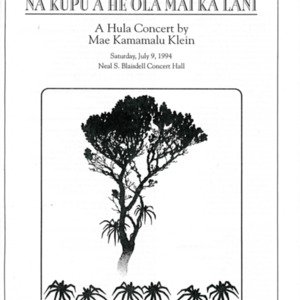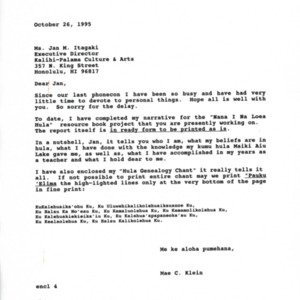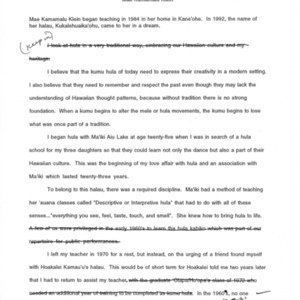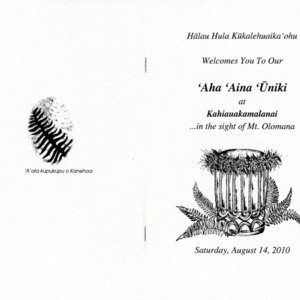Mae Kamāmalu Klein
Title
Mae Kamāmalu Klein
Subject
Nā Kumu Hula Mae Kamāmalu Klein - Nānā I Nā Loea Hula Volume 2 Page 60
Description
Kamāmalu Klein began teaching in 1984 in her home in Kāne‘ohe. In 1992 the name of her hālau, Kūkalehuaikaʻohu, came to her in a dream.
I look at hula in a very traditional way, embracing our Hawaiian culture and my heritage.
I believe that the kumu hula of today need to express their creativity in a modern setting. I also believe that they need to remember and respect the past even though they may lack the understanding of Hawaiian thought patterns, because without tradition there is no strong foundation. When a kumu begins to alter the mele or hula movements, the kumu begins to lose what was once part of a tradition.
I began hula with Mā‘iki Aiu Lake at age twenty-five when I was in search of a hula school for my three daughters so that they could learn not only the dance but also a part of their Hawaiian culture. This was the beginning of my love affair with hula and an association with Mā‘iki which lasted twenty-three years.
To belong to this hālau, there was a required discipline. Mā‘iki had a method of teaching her ‘auana classes called “Descriptive or Interpretive hula” that had to do with all of these senses: everything you see, feel, taste, touch, and smell. She knew how to bring hula to life.
I left my teacher in 1970 for a rest but on the urging of a friend found myself with Hoakalei Kamau‘u’s hālau. This would be of short term for Hoakalei told me two years later that I had to return to assist my teacher with the graduate ‘Ōlapa/Ho‘opa‘a of 1972. In the Sixties no one questioned the kumu hula; you just obeyed and did as you were told. I returned to Mā‘iki in 1973 and remained with my kumu until her passing in 1984. I was told by Mā‘iki to be a sponge and to absorb all that she had to share which included among other things, respect for my elders, attitude, programming, costuming, and the weaving of leis.
I became her first kokua kumu in 1973 after receiving my status as kumu. During this interim I learned the three rituals for hula ‘ūniki: the Hu‘elepo, the Midnight, and the ‘Ailolo Ceremonies. I have performed these rituals for my students respectively as they graduated from 1985 through 1994.
I teach hula in my home in Kāne‘ohe, the site chosen by my kumu hula. My mission in hula has been accomplished and I have fulfilled the promise made to Mā‘iki a few days before her passing, that I would open my school and pass on her tradition.
I believe that the hula kahiko is the only way to reflect on our kupuna and that the “hula renaissance” we are still experiencing is a rediscovery of those deep roots.
Without traditional ways we have no foundation for the hula kahiko, therefore a kumu must work hard at preserving what was handed down from one generation to another.
This is the legacy that I leave:
Kū Kalehuaika‘ohu Kū, Kū Uluwehikalikolehuaikauanoe Kū,
Kū Ka No‘eau Kū, Kū Kamaluolehua Kū, Kū Kamamolikolehua Kū
Kū Kalehuakiekieikaʻiu Kū, Kū Kalehua‘apapaneoka‘au Kū,
Kū Kealaolehua Kū, Kū
60 Mae Kamamalu Klein
I look at hula in a very traditional way, embracing our Hawaiian culture and my heritage.
I believe that the kumu hula of today need to express their creativity in a modern setting. I also believe that they need to remember and respect the past even though they may lack the understanding of Hawaiian thought patterns, because without tradition there is no strong foundation. When a kumu begins to alter the mele or hula movements, the kumu begins to lose what was once part of a tradition.
I began hula with Mā‘iki Aiu Lake at age twenty-five when I was in search of a hula school for my three daughters so that they could learn not only the dance but also a part of their Hawaiian culture. This was the beginning of my love affair with hula and an association with Mā‘iki which lasted twenty-three years.
To belong to this hālau, there was a required discipline. Mā‘iki had a method of teaching her ‘auana classes called “Descriptive or Interpretive hula” that had to do with all of these senses: everything you see, feel, taste, touch, and smell. She knew how to bring hula to life.
I left my teacher in 1970 for a rest but on the urging of a friend found myself with Hoakalei Kamau‘u’s hālau. This would be of short term for Hoakalei told me two years later that I had to return to assist my teacher with the graduate ‘Ōlapa/Ho‘opa‘a of 1972. In the Sixties no one questioned the kumu hula; you just obeyed and did as you were told. I returned to Mā‘iki in 1973 and remained with my kumu until her passing in 1984. I was told by Mā‘iki to be a sponge and to absorb all that she had to share which included among other things, respect for my elders, attitude, programming, costuming, and the weaving of leis.
I became her first kokua kumu in 1973 after receiving my status as kumu. During this interim I learned the three rituals for hula ‘ūniki: the Hu‘elepo, the Midnight, and the ‘Ailolo Ceremonies. I have performed these rituals for my students respectively as they graduated from 1985 through 1994.
I teach hula in my home in Kāne‘ohe, the site chosen by my kumu hula. My mission in hula has been accomplished and I have fulfilled the promise made to Mā‘iki a few days before her passing, that I would open my school and pass on her tradition.
I believe that the hula kahiko is the only way to reflect on our kupuna and that the “hula renaissance” we are still experiencing is a rediscovery of those deep roots.
Without traditional ways we have no foundation for the hula kahiko, therefore a kumu must work hard at preserving what was handed down from one generation to another.
This is the legacy that I leave:
Kū Kalehuaika‘ohu Kū, Kū Uluwehikalikolehuaikauanoe Kū,
Kū Ka No‘eau Kū, Kū Kamaluolehua Kū, Kū Kamamolikolehua Kū
Kū Kalehuakiekieikaʻiu Kū, Kū Kalehua‘apapaneoka‘au Kū,
Kū Kealaolehua Kū, Kū
60 Mae Kamamalu Klein
Citation
“Mae Kamāmalu Klein,” Nā Kumu Hula Archive, accessed August 25, 2025, https://nakumuhula.org/archive/items/show/128.














